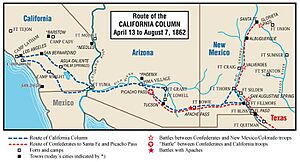California Column facts for kids
The California Column was a group of volunteer soldiers. They were part of the Union Army during the American Civil War. These brave soldiers traveled a very long way. They marched over 900 miles from California. Their journey took them through Arizona and New Mexico Territory. They reached the Rio Grande river and even went to El Paso, Texas. This amazing march happened between April and August of 1862.
Contents
What Was the California Column?
The California Column was a special military group. It was made up of soldiers who volunteered from California. Their main job was to help the Union win the Civil War in the American Southwest. They faced many challenges, including long marches and battles.
Getting Ready: How the Column Formed
The California Column started with about 1,500 well-trained soldiers. It included ten companies from the 1st California Infantry. There were also five companies of the 1st Regiment California Volunteer Cavalry. Plus, Company B from the 2nd Regiment California Volunteer Cavalry joined them. A special artillery unit, Light Battery A, was also part of the group. Later, more soldiers joined from the 5th Regiment California Volunteer Infantry. This brought the total strength of the Column to 2,350 men.
Their Big Journey: Why They Marched
The leader of the California Column was Colonel James Henry Carleton. He was promoted to a high-ranking general during the march. His main goal was to push Confederate troops out of the New Mexico Territory. In 1861, a smaller Confederate force from Texas had taken over some Union forts there. The Confederates even got people in their own Territory of Arizona to join their army.
The Union soldiers often walked in their woolen uniforms. This was tough, especially in the hot desert. They began their journey from Fort Yuma near the Colorado River. To avoid running out of water and food, they traveled in small groups. These groups were spaced a few days apart. They followed the old route of the Butterfield Overland Mail. This route had stations filled with supplies. Union forces had stored food and grain there before the war started.
Facing Challenges in Arizona
Confederate volunteers from Arizona tried to stop the Column. Captain Sherod Hunter led these Arizona Confederates. They captured a Union agent named Ammi M. White. They also destroyed White's flour mill at Casa Blanca. Supplies of food and animal feed were also ruined at other stations. This made the Column's progress slower.
Most messages sent by General Carleton to General Edward Canby were caught by the Confederates. One Union patrol was even captured at White's Mill. This happened near the Pima Indian villages.
Important Fights in Arizona
The California Column had two small fights with the Confederates. The first was a skirmish at Stanwix Station. This happened in late March 1862. Confederates were trying to burn food for animals there. The second fight was in mid-April at the Picacho Pass. This was when the Column marched towards Tucson. Their quick arrival almost trapped the Confederate soldiers who were leaving Tucson.
It took until late June for a scout named John W. Jones to get a message through. He managed to escape from Apache warriors. His message reached General Canby and said: "The Column from California is really coming." Later, in July, 140 men from the Column fought famous Apache leaders. These leaders were Cochise and Mangas Coloradas. This battle happened at Apache Pass.
Arriving in New Mexico
When parts of the California Column reached the Rio Grande river, they had to wait. A huge spring flood that year delayed their crossing for a week. Once they crossed, they found that the Confederates had already left. The Confederates had retreated into Texas. General Carleton followed them into West Texas. He captured the town of Franklin, which is now El Paso. He even advanced as far as Fort Quitman.
After taking over West Texas, the California Column soldiers stayed there. They protected the area to stop Confederates from returning. Their main job was to guard towns and forts in New Mexico Territory. They also fought against the Apaches and Navajo tribes. Other U.S. Army soldiers replaced them in 1866.


